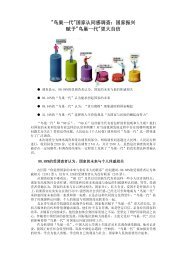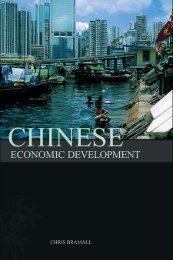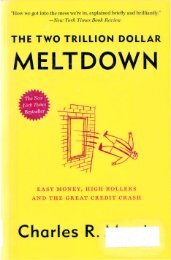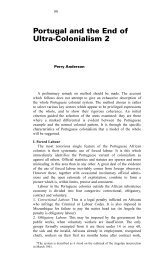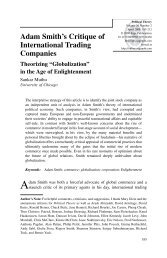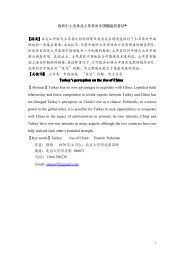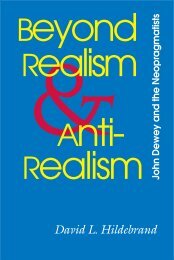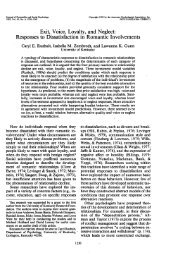Battle for China's Past : Mao and the Cultural Revolution
Battle for China's Past : Mao and the Cultural Revolution
Battle for China's Past : Mao and the Cultural Revolution
You also want an ePaper? Increase the reach of your titles
YUMPU automatically turns print PDFs into web optimized ePapers that Google loves.
THE BATTLE FOR CHINA’ S PAST<br />
Chang <strong>and</strong> Halliday’s claim that is not supported by evidence? First of<br />
all, <strong>the</strong> first note entry ‘<strong>Mao</strong> order, 3 Dec. 1930’ is not exactly <strong>the</strong><br />
wording in <strong>the</strong> text. We <strong>the</strong>re<strong>for</strong>e cannot be sure what <strong>Mao</strong> ordered.<br />
Second, <strong>the</strong> text aims to show <strong>Mao</strong> ordered <strong>the</strong> mass slaughter of his<br />
opponents, but which reference is it that is cited <strong>for</strong> this claim? Is it <strong>the</strong><br />
citation of Dai & Luo <strong>and</strong> Vladmirov? According to <strong>the</strong> order of<br />
appearance <strong>the</strong>se two references are cited only to refer to <strong>the</strong> text<br />
be<strong>for</strong>e ‘AB meeting’, but <strong>the</strong> ‘slaughter’ sentence appears only after<br />
‘AB meeting’ in <strong>the</strong> text. Are we to underst<strong>and</strong> <strong>the</strong>n that it is <strong>the</strong> citation<br />
of ‘<strong>Mao</strong> to Shanghai, 20 Dec. 1930, *ZDJC vol. 14, p. 636 (E: MRTP<br />
vol. 3, pp. 704–5); *Liou Di, letter to Shanghai, 11 Jan. 1931, RGASPI,<br />
cit.; *Provincial Action Committee, Emergency Announcement no. 9, 15<br />
Dec. 1930 RGASPI, 514/1/1008’ that supports <strong>the</strong> ‘slaughter’ statement?<br />
Or are <strong>the</strong>se references actually citations <strong>for</strong> <strong>the</strong> ‘AB meeting’?<br />
Third, <strong>the</strong> sentence ‘Put <strong>the</strong>m all down’, he ordered, <strong>and</strong> <strong>the</strong>n<br />
‘slaughter en masse in all counties <strong>and</strong> all districts’ does not make<br />
sense. Does it mean that <strong>Mao</strong> ordered his opponents to be put down<br />
<strong>and</strong> <strong>the</strong>n slaughtered? One would think that <strong>the</strong> sentence in quotation<br />
marks is a translation from Chinese or Russian by <strong>the</strong> co-authors. One<br />
would underst<strong>and</strong> <strong>the</strong> first part of <strong>the</strong> sentence ‘put <strong>the</strong>m all down’<br />
means ‘to get rid of <strong>the</strong>m by killing <strong>the</strong>m’ which is <strong>the</strong> same as <strong>the</strong><br />
second part of <strong>the</strong> sentence ‘slaughter en masse’ What is <strong>the</strong> word<br />
‘<strong>the</strong>n’ in <strong>the</strong> sentence <strong>for</strong>? What is possible, or what <strong>the</strong> co-authors<br />
possibly mean to say, is that <strong>Mao</strong> gave <strong>the</strong> order by saying ‘put <strong>the</strong>m<br />
all down’ <strong>the</strong>n someone else carried out <strong>the</strong> order <strong>and</strong> ‘slaughtered’<br />
<strong>the</strong>m. If that is <strong>the</strong> case why don’t <strong>the</strong> co-authors do that?<br />
Appearance <strong>and</strong> instant satisfaction<br />
What is clear is that <strong>the</strong> authors cannot support <strong>the</strong>ir claims as well as<br />
might first appear. There are many examples in <strong>the</strong> text. A common<br />
move employed by <strong>the</strong> authors is to cite a reference or even references<br />
to a trivial statement or a piece of insignificant in<strong>for</strong>mation, which is<br />
<strong>the</strong>n followed immediately by a substantial or serious claim without<br />
reference. There is a source cited <strong>for</strong> <strong>the</strong> statement that ‘On 29 May he<br />
had to return to Red Jiangxi’ (p. 118). But immediately after this Chang<br />
<strong>and</strong> Halliday claim that <strong>Mao</strong> led ‘<strong>the</strong> tens of thous<strong>and</strong>s of troops’ into<br />
‘an isolated cul-de-sac’ <strong>and</strong> ‘a large number fell ill <strong>and</strong> died’ (p. 118), a<br />
claim made without any supporting source. However, because <strong>the</strong>re is<br />
a reference to <strong>the</strong> first sentence <strong>the</strong> appearance is that <strong>the</strong> substantial<br />
claim is also backed by a reference.<br />
The reader who is not a professional in <strong>the</strong> field would not take <strong>the</strong><br />
trouble to check whe<strong>the</strong>r <strong>the</strong> claims made in <strong>the</strong> book have really been<br />
made on solid evidence. This is clever showmanship: it is difficult to<br />
[ 70 ]





